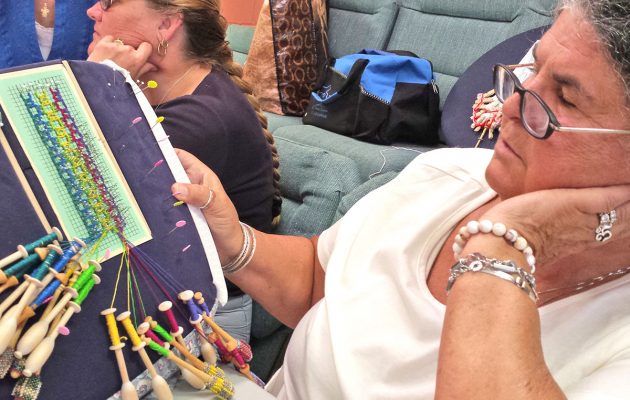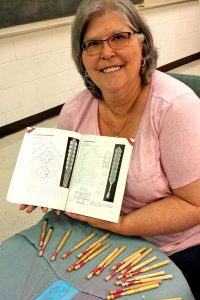Centuries-old art form still alive in Northeast Florida

Until the French Revolution sent lace makers, along with their patrons, to the guillotine in the late 1700s, the art of handmade bobbin lace was in high demand among royalty. Thankfully, for a group of lace makers in Northeast Florida, the art form is no longer a threat to life.
Once a symbol of prestige in Italy, Belgium and France, intricate, handmade lace was often smuggled into England in coffins, placed in hollowed-out loaves of bread, hidden by ladies in their garments, rolled into gentlemen’s brandy flasks, and through other ingenious methods devised to transport this costly, luxurious item for collars, cuffs, gloves, head coverings and other adornments, including decorations for church altars.
The Jacksonville Florida Lacers meet twice a month to keep the historic artform alive, creating items of delicacy and beauty. Carol Robson from St. Mary’s, Georgia joined in 1991 and drives down to facilitate the group, which gathers from Arlington, Murray Hill and Mandarin and as far south as St. Augustine, Palm Coast and Ormond Beach.
The lacers were introduced to the art in a variety of ways. Roseanna Torruella learned bobbin lace making as a child in Puerto Rico. Kay Hymes lived next door to the person who owned a lace making supply business and was inspired to learn. Mary Kight saw a travel show on television about Belgium and was inspired to begin lacing. Donna Paganodenny said, “I painted until my mother put a crochet hook in my hand.”
Most of the women have experience with textile arts such as embroidery, tatting, crocheting and knitting. Linda Schleel has crocheted since age five and later taught tatting. Many have participated in craft shows, fairs and colonial craft exhibits.
Murray Hill resident Connie Temple was inspired to take up lacing when she saw tiny, dollhouse dolls wearing intricate lace outfits at an art festival. She called the International Lacer’s Association who directed her to someone in Gainesville then finally to Robson in Jacksonville.
“Most of us do Torchon lace, which is the simplest. It is very therapeutic. There is a soothing rhythm to the clicking of the bobbins,” said Temple. “I had been away from it for a few years but after a traumatic and stressful year I decided to go back, and Carol is so encouraging. She is there for us – there is no question that we have put to her that she doesn’t know the answer, or she will go and find out. She has pushed us to go a little farther than we thought we could.”
Robson is a master craftsman and, the group joked, a tough taskmaster as well. “Rip it out,” “Go back, go back – do it right” are her catchphrases. Denise Williams is the newest member, and all agree that Robson is patient, kind and generous with her time, information and patterns.
Like her daughter, Sheyla Ogilvie, who assists, Robson is dedicated to teaching and continuing this dying artform. She said the most difficult thing about teaching is helping someone figure out a mistake and one of the women quipped that making bobbin lace is both the “most soothing and the most aggravating activity.”
With numerous bobbins of thread, pins which make up the pattern set in a pillow, and a complicated manner of braiding and twisting the threads, one can see how frustration could vie for the therapeutic value, although they agree time disappears when they get into a zone as the highly decorative bobbins click and the patterns emerge.
“I would rather do this than go to a psychiatrist,” remarked longtime lacer Torruella.
Persons interested in learning this fascinating craft can contact Carol Robson at (912) 882-6803. The Jacksonville Florida Lacers meet at Ortega United Methodist Church, 4807 Roosevelt Blvd., the second and fourth Wednesday of the month, at 10 a.m.
By Peggy Harrell Jennings
Resident Community News







